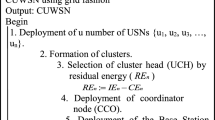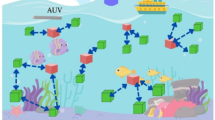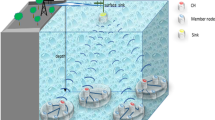Abstract
Underwater Acoustic Networks are gaining in popularity because of their usage in underwater communication. The communication is facilitated with sensors and AUVs (Autonomous Underwater Vehicles), also termed as UWCNs (Underwater Wireless Communication Networks). The QoS expected of underwater networks is effective transmission along with an extended lifespan of the network. This can be achieved with strategically placed clusters underwater which help in transmitting effectively. Clustering can be strategically used to securely transmit the data while conserving the node energy.This paper proposes an Optimal and Energy Efficient Framework for Cluster Communication Based Routing Protocol for UWCNs (OEEFCP).This scheme works in two phases. Phase-1 focuses on selecting an optimal CH (a Robust Cluster Head) which will be responsible for selecting an efficient carrier of data. Additionally, we have used probability in selecting the optimum number of clusters and CHs. Phase-2 uses an effective multipath energy model which will focus on transmitting data through effective communication channels. A RSSI (Received Signal Strength Indicator) value is used to determine a gateway node out of the optimal CHs. The robust gateway nodes thus selected will supply data to the AUVs (Autonomous Underwater Vehicles) nearest to them. The AUV nodes will then transfer the data via a communication link and thereon towards a destination on land. The proposed technique focuses on a cost effective solution for underwater transmission. The proposed OEEFCP is analyzed with existing schemes such as OC-TARE-TOPSIS and TARE-TOPSIS protocols, using the NS2 simulator. The analysis confirms that the proposed OEEFCP is capable of achieving a good performance in achieving an extended network lifespan, throughput, energy conservation and a maximized PDR. Our proposed OEEFCP scheme shows a 65% increase in PDR over the other existing methods.








Similar content being viewed by others
References
Sathiamoorthy, J., & Ramakrishnan, B. (2018). A competent three-tier fuzzy cluster algorithm for enhanced data trans-mission in cluster eaack manets. Soft Computing, 22(19), 6545–6565.
Mohamed Jafar, O. A., & Sivakumar, R. (2010). Ant-based clustering algorithms: A brief survey. International Journal of Computer Theory and Engineering, 2(5), 1793–8201.
Banerjee, S., & Khuller, S. (2001). A clustering scheme for hierarchical Control in multi-hop wireless networks. In Proceedings of the annual joint conference of the IEEE computer and communications societies (INFOCOM) (pp. 1028–1037).
Sathiamoorthy, J., & Ramakrishnan, B. (2017). Energy and delay efficient dynamic cluster formation using hybrid AGA with FACO in EAACK MANETs. Wireless Networks, 23(2), 371–385.
Sathiamoorthy, J., & Ramakrishnan, B. (2016). CEAACK - a reduced acknowledgment for better data transmission for manets. International Journal of Computer Network and Information Security (IJCNIS), 8(2), 64–71.
Bokhari, M. U., Hamatta, H. S. A., & Siddigui, S. T. (2012). A review of clustering algorithms as applied in MANETs. International Journal Advanced Research in Computer Science and Software Engineering, 2(11), 364–369.
Jayaraman, S., Mohanakrishnan, U., & Ramakrishnan, A. (2021),” A Trusted Water Fall Model for Efficient Data Transmission in VANET”, Wireless Personal Communications, pp. 1–28.
Agarwal, R., & Motwani, M. (2009). Survey of clustering algorithms for MANET. International Journal on Computer Science and Engineering, 1(2), 98–104.
Krishan, P. (2013). A study on dynamic and static clustering based routing schemes for wireless sensor networks. International Journal of Modern Engineering Research (IJMER), 3(2), 1100–1104.
Sathiamoorthy, J., & Ramakrishnan, B. (2017). Design of a proficient hybrid protocol for efficient route discovery and secure data transmission in CEAACK MANETs. Journal of information security and applications, 36, 43–58.
Malik, M., & Singh, Y. (2013). Analysis of LEACH protocol in wireless sensor networks. International Journal of Advanced Research in Computer Science and Software Engineering, 3(2), 178–184.
Singh, A. P., Sharma, N., & Roy, N. R. (2013). Residual energy and distance based energy-efficient communication protocol for wireless sensor network”. International Journal of Computer Applications, 74(12), 11–16.
Soni, S., & Dey, B. (2014) Dynamic selection of cluster head in cluster of cluster heads within the cluster in heterogeneous wireless sensor network, In IEEE International Conference on Advanced Communications, Control and Computing Technologies, pp. 877–881.
Boopalan, S., & Jayasankari, S. (2021). Dolphin swarm inspired protocol (DSIP) for routing in underwater wireless sensor networks. International Journal of Computer Networks and Applications (IJCNA), 8(1), 44.
Singh, K., & Gupta, R. (2021). Performance evaluation of a MANET based secure and energy optimized communication protocol (E2S-AODV) for underwater disaster response network. International Journal of Computer Networks and Applications (IJCNA), 8(1), 11–27. https://doi.org/10.22247/ijcna/2021/207979.
Priyadarshini, R. R., & Sivakumar, N. (2021). Cluster head selection based on minimum connected dominating set and bi-partite inspired methodology for energy conservation in WSNs. Journal of King Saud University-Computer and Information Sciences, 33(9), 1132–1144.
Sathiamoorthy, J., & Ramakrishnan, B. (2017). Energy and delay efficient dynamic cluster formation using improved ant colony optimization algorithm in eaack manets. Wireless Personal Communication, 95(2), 1531–1552.
Haseeb, K., Abbas, N., Saleem, M. Q., Sheta, O. E., Awan, K., Islam, N., & Salam, T. (2019). RCER: Reliable cluster-based energy-aware routing protocol for heterogeneous wireless sensor networks. PLoS ONE, 14(9), 1–24.
Hassan, A., Anter, A., & Kayed, M. (2021). A robust clustering approach for extending the lifetime of wireless sensor networks in an optimized manner with a novel fitness function. Sustainable Computing: Informatics and Systems, 30, 1–10.
Usha, M., Sathiamoorthy, J., Ashween, R., & Ramakrishnan, B. N. (2020). EEMCCP-a novel architecture protocol design for efficient data transmission in underwater acoustic wireless sensor network. International Journal of Computer Networks and Applications (IJCNA)., 7(2), 28–42.
Jayaraman, S., Bhagavathiperumal, R., & Mohanakrishnan, U. (2018). A Trusted Waterfall framework based peer-to-peer protocol for reliable and energy efficient data transmission in eaack manets. Wireless Personal Communications, 102(1), 95–124.
Rana, S., Bahar, A. N., Islam, N., & Islam, J. (2015). Fuzzy based energy efficient multiple cluster head selection routing protocol for wireless sensor networks. International Journal of Computer Network and Information Security, 4, 54–61.
Jayaraman, S., Bhagavathiperumal, R., & Mohanakrishnan, U. (2018). A three layered peer-to-peer energy efficient protocol for reliable and secure data transmission in eaack manets. Wireless Personal Communications, 102(1), 201–227.
Heinzelman, W. R., Chandrakasan, A., & Balakrishnan, H. (2000). Energy-efficient communication protocol for wireless microsensor networks. In System Sciences, 2000. Proceedings of the 33rd Annual Hawaii International Conference on (pp. 10-pp). IEEE.
Heinzelman, W. B., Chandrakasan, A. P., & Balakrishnan,. (2002). An application-specific protocol architecture for wireless microsensor networks. Wireless Communications, IEEE Transactions on, 1(4), 660–670.
Forghani, Azadeh, Amir Masoud Rahmani, and Ahmad Khademzadeh. "QCTC: QoS-based clustering topology control algorithm for wireless sensor networks." In 2008 International Conference on Advanced Computer Theory and Engineering, pp. 966–970. IEEE, 2008
Taheri, H., Neamatollahi, P., Younis, O. M., Naghibzadeh, S., & Yaghmaee, M. H. (2012). An energyaware distributed clustering protocol in wireless sensor networks using fuzzy logic. Journal of Ad Hoc Networks, 10(7), 1469–1481.
Sathiamoorthy, J., Ramakrishnan, B., & Usha, M. (2015). Design of a competent broadcast algorithm for reliable transmission in CEAACK MANETs. Journal of Network Communications and Emerging Technologies, 5(1), 144–151.
Zou, Y., & Chakrabarty, K. (2005). A distributed cover- age-and connectivity-centric technique for selecting active nodes in wireless sensor networks. Computers, IEEE Transactions on, 54(8), 978–991.
Nayyar, A., Puri, V., & Le, D. N. (2019). Comprehensive analysis of routing protocols surrounding underwater sensor networks (UWSNs). In Data management, analytics and innovation (pp. 435–450). Singapore: Springer.
John, S., Menon, V. G., & Nayyar, A. (2020). Simulation-based performance analysis of location-based opportunistic routing protocols in underwater sensor networks having communication voids. In Data Management, Analytics and Innovation (pp. 697–711). Singapore: Springer.
Nayyar, A., & Balas, V. E. (2019). Analysis of simulation tools for underwater sensor networks (UWSNs). In International conference on innovative computing and communications (pp. 165–180). Singapore: Springer.
Author information
Authors and Affiliations
Contributions
Dr SJ—Technical and conceptual content, collection of research data and architectural design of the framework. Dr. UM—Corresponding author of the manuscript.Domain Expertise, guidance and counseling on the writing of the paper. Dr. SR – Logical evaluation and technical support. BNR- Research data collection and evaluation of data.
Corresponding author
Ethics declarations
Conflict of interest
There are no conflicts of interest between authors.
Human and animal rights
There are no human participants and/or animals involved in this manuscript.
Informed consent
There are no informed consent criteria in this manuscript.
Additional information
Publisher's Note
Springer Nature remains neutral with regard to jurisdictional claims in published maps and institutional affiliations.
Rights and permissions
About this article
Cite this article
Sathiamoorthy, J., Usha, M., Ravichandran, S. et al. OEEFCP – an optimal energy efficient framework employing cluster communication based routing protocol for UWCNs. Wireless Netw 28, 1389–1409 (2022). https://doi.org/10.1007/s11276-022-02901-5
Accepted:
Published:
Issue Date:
DOI: https://doi.org/10.1007/s11276-022-02901-5




